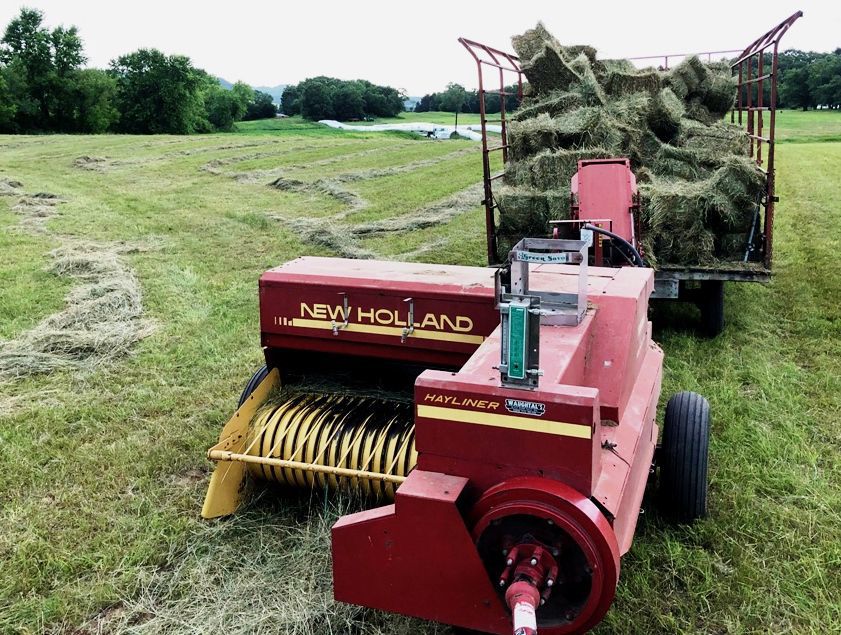Back Home by Chris Hardie
» Download this column as a Word document
» Download photos that accompany this story
» More columns by Chris Hardie
» Chris Hardie’s headshot
The rain was falling in sheets and the wind kicked up as I scrambled to cover my wagon of bales with several tarps.
Wiping water from my eyes, I jumped off the wagon. I backed the baler into the shed as cracks of lightning and rumbles of thunder rolled across the valley. I shut the tractor off and stood inside the shed, which echoed with the sounds of the large raindrops pelting the metal roof.
I was soaking wet, miserable, frustrated and asking myself — “Is baling hay supposed to be this difficult?” The concept of making hay is a pretty simple agricultural process — cut green fodder, allow it to dry, bale it and store it for livestock feed.

We’ve come a long way since the days of the scythe and rake, but one thing has not changed regardless of the method of harvest. We can’t make dry hay without the sun shining. Without the drying power of the sun, the hay will not dry and cannot be stored without spoiling.
Many of the large farms these days are putting up wet hay, baling and wrapping it in plastic. The hay then goes through fermentation and becomes palatable silage with minimum spoilage.
Wet bales seem to be the only option so far this summer for harvesting hay. With the exception of a few consecutive days in early June, we can’t seem to go a day or two without rain. Even when it doesn’t rain, the days are cool, cloudy and damp.
Finally, it looked like there was a chance. There was hot weather in the forecast with a 30 percent chance of rain on one day. We cut about 10 acres of hay — about a third of my fields. The plan was to let them dry for two days and then try to put up some small squares.
The plan changed when the 30 percent chance was increased to 80 percent at the end of day two. That sent me scurrying with the following sequence of events, which I crammed into three hours.
- I pulled the baler out of the shed, greased it and checked the twine.
- I spent 45 minutes jump-starting a tractor with a dead battery — and still no hood from the time two years ago when it started on fire while I was baling.
- While the battery was charging I used a rope to carefully lower the broken electric elevator out of the barn window, with plans to replace it with the tractor-powered one.
- I pulled three bale wagons from the weeds to quickly check the tires, which miraculously were all still holding air.
- I hooked the tractor to the rake, which hasn’t had a jack stand for years; the hitch is propped up on wooden blocks and requires a mighty heave to move.
- I raked about 5 acres of hay, all the while keeping my eye on the darkening sky.
- I hooked up the tractor and baler, and then fussed with the power-takeoff shaft for about 10 minutes until my hands, pants and shirt were black from grease.
- I frantically searched the farm for a hitch pin because the one that has been on the back of the baler for years had mysteriously disappeared. I finally cobbled together a hitch from a bolt and washer.
- I began baling about noon under full clouds, with ominous black clouds to the north. The bales were heavy.
- It was just starting to sprinkle when I smelled what I thought was burning leaves. I looked back and smoke was coming from the belt chute. I shut the baler down and found embers of dried hay – remnants of the last time the baler was used in 2018 – had ignited along the shaft that drives the belts.
- I grabbed my pliers and used the handles to rake out the burning leaves, simultaneously checking the state of my bladder just in case the fire spread out of control. It was my No. 2 option and one that I used the previous time the tractor started fire. That option was not needed this time. I was able to stamp out the fire just as the rain started coming down heavier. I headed for home.
- As I stood in the shed waiting for the rain to let up, I looked at the bright side. I was able to do a few bales and the rest of the hay wasn’t raked. A little rain won’t hurt that.
But overnight the little rain turned into a deluge. I rolled out of bed at 3:30 a.m. to find water pouring into our basement. More than 4 inches of rain fell in an hour.
The morning light confirmed my fears. The storm had washed away the road crossing our creek, leaving us unable to reach two of our best hayfields. The tarps could not keep my partial load from being soaked. I was only able to salvage a few bales.
There are some years when I’m already taking my second cutting at this time. At this rate, I’ll be lucky to take two cuttings all year.
It shouldn’t be this hard.
Chris Hardie spent more than 30 years as a reporter, editor



